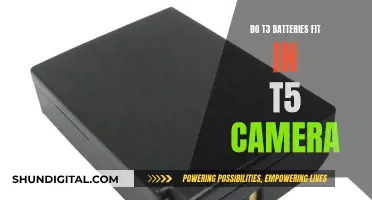
Laptop webcams have long been considered terrible, with grainy, dark, and poor-quality visuals. This has become especially evident in the age of Zoom, where many people are now reliant on their laptop cameras for work and socialising. The issue is partly due to the thinning of laptops, leaving less room for camera hardware, and manufacturers buying the cheapest components. Additionally, laptop cameras have low priority for manufacturers, who assume that users who require better quality will purchase an external webcam.
| Characteristics | Values |
|---|---|
| Image quality | Crappy, grainy, dark, potato quality |
| Camera hardware | Low-spec, low-resolution, small sensors, small lens |
| Lighting | Poor low-light performance |
| Discoloration | Green/yellowish tint |
| Thickness | Thin laptops have less room for better cameras |
| Cost | Manufacturers buy the cheapest components possible |
| Priority | Low priority for manufacturers |
| Bandwidth | Insufficient bandwidth for video chats when running multiple tasks |
| Software | Outdated imaging software |
What You'll Learn

Laptop cameras have worsened over time
The decline in laptop camera quality can be attributed to a combination of factors, including the shrinking size of display bezels and the decreasing thickness of laptop lids. These design choices leave less room for manufacturers to incorporate high-quality camera hardware. Additionally, laptop cameras were previously considered a low-priority feature, as most users did not utilise them frequently before the pandemic. As a result, manufacturers often opted for lower-spec camera hardware to reduce costs.
The impact of thin laptop designs on camera quality is evident in the case of the Dell XPS 13. Dell worked with camera vendors to create a 2.25mm camera module that could fit into the tiny top bezel of the laptop screen. While innovative, this smaller camera resulted in a reduction in sensor and lens size, leading to a decrease in image quality. This design set a precedent for other thin-bezel laptops, further perpetuating the issue.
The issue of poor laptop camera quality has led to a rise in the use of external webcams, with many individuals investing in higher-quality alternatives. While this provides a temporary solution, it also highlights the need for manufacturers to prioritise improving integrated laptop cameras. As remote work and video calls become more prevalent, it is likely that consumers will demand better built-in webcam options.
While there are some limitations to the improvements that can be made, such as the physical constraints of thinner laptops, there is still room for innovation. For example, users may be willing to accept slightly thicker laptops or unique camera designs if it results in a significant increase in webcam quality. Until manufacturers address this issue, consumers will continue to rely on external webcams or their smartphones for a better video call experience.
Surveillance Cameras: DIY Home Security on a Budget
You may want to see also

Manufacturers buy cheap components
The second reason laptop cameras are so bad is that manufacturers buy the cheapest components possible. This is despite the fact that laptops are expensive, with some costing up to $2000. The Intel MacBook Pro 16, which costs $2,399, has a webcam that can record videos at just 720p. The Dell XPS 17, which costs about $2650, has a webcam that maxes out at 720p. Many HP Elite series and MSI laptops also have webcams that max out at 720p, despite costing thousands of dollars.
The Microsoft Surface Book lineup has used a 1080p webcam since its initial launch in 2015, but the 2021 Surface Laptop 4 is limited to a 720p shooter. The 2021 M1 MacBook Pro and Air lineup are still at 720p.
The new 24-inch iMac comes with a 1080p shooter, which Apple says is the best camera hardware ever on a Mac. The iPad Pro models also have far better cameras than the MacBooks.
The problem of poor-quality laptop cameras is not universal, and there are some laptops with better cameras. The Sony Vaio Z series notebooks have 1920 x 1080 resolution on a 13" screen. The Dell M4500 15.6" mobile workstation and Studio 15 have a 1980 x 1080 option. The Dell Inspiron 6000 had a resolution of 1680x1050, and higher options were available. The Sony EB series has a resolution of 1920x1080. The Dell Laptop Kokopelli_Rocks has a 1920x1200 15-inch monitor. The Gateway XP Pro has a resolution of 1680x1050.
Culver City Camera Tickets: Legality and Your Rights
You may want to see also

Cameras are low on the priority list
Webcams have been around for decades, but they haven't improved much over the years. Even as the cameras in our phones have become near-perfect, laptop cameras have remained mostly terrible. So, why are laptop manufacturers neglecting this piece of hardware?
One reason could be that laptops have become thinner, leaving less room for the webcam. Manufacturers may also be buying the cheapest components possible to keep costs down. After all, most people didn't use their laptop webcams much before the pandemic, so it wasn't a priority.
Another reason could be that laptop makers assume that anyone who is serious about webcam usage will buy an external webcam. They may not want to invest in improving the built-in cameras, as it could raise the costs of their products.
Additionally, there may be technical limitations to improving webcams. They are designed to be small devices that fit onto existing monitors or laptop lids, so they use small camera modules with tiny image sensors. These modules have been good enough for years, so there hasn't been much incentive to change.
Whatever the reasons, it's clear that laptop cameras have been low on the priority list for manufacturers. However, with the rise of remote work and video calls, this may need to change. People are now relying on their laptop cameras more than ever, and the demand for better quality is growing.
The Evolution of Cameras: Capturing Moments, Freezing Time
You may want to see also

They're small and thin
Laptop cameras have been described as "mostly terrible" and "stuck in time". One reason for this is that laptops have become thinner and thinner over time. The shrinking size of display bezels and the slimming down of the laptop lid thickness leave less room for camera hardware.
The small and thin nature of laptop cameras is a significant contributing factor to their poor performance. The limited space available for the camera module restricts the size and quality of the lens, sensor, and other components. As a result, laptop cameras often produce lower-resolution images and videos compared to those captured by smartphone cameras or dedicated webcams.
The compact design of laptop cameras also affects the amount of light that can enter the camera. A smaller lens and sensor typically result in reduced light sensitivity, leading to darker or noisier images, especially in low-light conditions. This can make it challenging to use a laptop camera in dimly lit environments, requiring additional lighting to compensate.
Furthermore, the thin design of laptops may impact the placement of the camera. In some cases, the camera may be positioned too close to the user, resulting in an unflattering perspective or an awkward angle. This can be particularly noticeable during video calls, where the person on the other end may see an unnaturally close-up view of the user's face.
While thin laptops offer portability and aesthetic appeal, their limited form factor directly impacts the camera quality. Manufacturers often prioritize thinness and lightweight construction over camera performance, resulting in the persistent mediocrity of laptop cameras.
Vivitar Lenses: Camera-Specific or Universal?
You may want to see also

External cameras are a better option
The pandemic has forced many of us to work from home and attend endless video calls, and that's when we started to pay attention to the quality of our computer cameras. It turns out that the cameras in our laptops are mostly terrible and don't seem to be getting any better.
Laptops have become thinner and manufacturers buy the cheapest components possible. As a result, the cameras in laptops are often of low spec and poor quality.
An external webcam can dramatically enhance your video call experience. If you have an older laptop or a desktop computer, an external camera is a great option. They are also useful if your laptop’s integrated webcam is in an unflattering or inconvenient location.
When choosing an external camera, consider the resolution, frame rate, skin-tone accuracy, and microphone quality. You may also want to look for features such as subject tracking and a privacy shutter.
Some recommended external cameras
There are a variety of external cameras available on the market, with options to suit different budgets and needs. Here are some popular choices:
- Logitech Brio 505: This webcam offers excellent image quality, ease of setup, and helpful software. It has a privacy shutter and a tripod mount.
- Insta360 Link: This webcam has smart features, 4K resolution, and reliable exposure and white balance. It also has smooth background blur and automatic privacy mode.
- Anker PowerConf C200 2K: A budget-friendly option that delivers respectable footage. It has a privacy screen and can tilt up and down.
- Razer Kiyo Pro Ultra: Shoots in 4K and has excellent noise and low-light handling, as well as a built-in privacy shutter and omnidirectional mic.
- Elgato Facecam Pro: Shoots in 4K at 60fps and delivers snappy autofocusing. It is, however, quite expensive.
- Logitech StreamCam: A reliable and affordable option for casual users and those who need something for work. It has a flippable design and can be mounted on a tripod.
So, if you're looking to improve your video call experience, investing in an external camera is definitely a good option.
Focusing Luma Camera: Tips for Crisp and Clear Shots
You may want to see also
Frequently asked questions
Laptop cameras have worsened over the years due to the shrinking size of display bezels and the slimness of the laptop lid, which leaves less room for camera hardware. Manufacturers also tend to buy the cheapest components and assume that users who are serious about webcam usage will purchase external cameras.
Adjusting the lighting conditions, background, and video settings can help improve the quality of a laptop camera. Additionally, ensuring that the laptop is not overloaded with multiple tasks and setting up the quality of service (QoS) on your router can also help.
The image quality of a laptop camera can be affected by the camera itself, the environment, and the imaging software being used. Poor lighting conditions, such as a lack of light or too much light behind the subject, can distort the image.
Yes, users can purchase an external webcam, use their smartphone, or opt for a 2-in-1 device like the Surface Pro 7 or iPad Pro, which offer better camera quality.
Not necessarily. Even some high-end laptops, such as the Dell XPS 17 and MacBook Pro, have been known to have subpar webcam quality.







